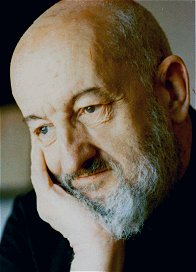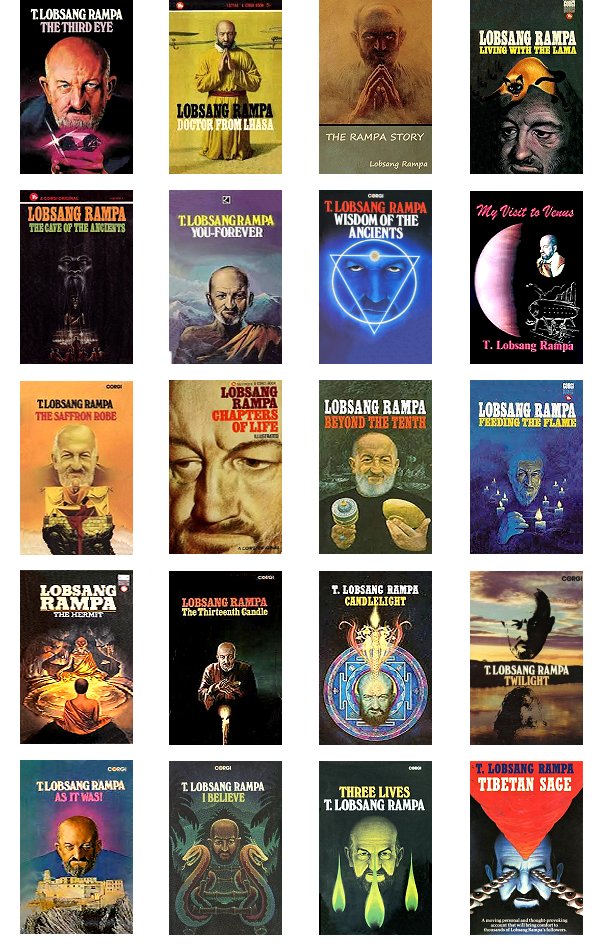Sixties
City presents
a wide-ranging series of
articles on all aspects of the Sixties, penned by the creator of the iconic
60s music paper Mersey
Beat
|
Sixties
City presents
a wide-ranging series of
articles on all aspects of the Sixties, penned by the creator of the iconic
60s music paper Mersey
Beat
|
|||||
|
 |
There
was a counterculture in Britain during the Sixties which included interest
in Indian spirituality and mysticism. Books such as 'Siddartha', (about
the Buddha) and Indian religious books like 'The Upanishads'. There was
also, due no doubt to The Beatles, the transcendental meditation practised
by the Maharishi Mahesh Yogi and the Indian music of Ravi Shankar. Interest
in the spiritual had already arrived earlier in the UK with the publishing
of 'The Third Eye' by Lobsang Rampa which sold 500,000 copies in two years.
This was his first book, published in November 1956, which was an autobiographical
history of his life in Tibet during the time of the 13th Dalai Lama. Rampa
followed with a series of books about Tibetan life, spiritual enlightenment,
and mysticism, with themes such as astral projection, predictions of the
future, future wars, crystal gazing, aura deciphering, the lost years of
Jesus and meditation. 'The Third Eye' depicted Rampa entering the Chakpori Lamasery in Tibet at the age of seven. He described how a small hole was drilled into his forehead to open his third eye and arouse powers of clairvoyance, see auras and develop spiritual energies. He even claimed to have seen a mummified version of himself from a previous incarnation and witnessed a Yeti. He then entered a temple of Tibetan medicine under the tutelage of Lama Mingyar Dondup, was certified as a medical priest at the age of 12 and at the age of 16 he was promoted to Lama. The Dalai Lama then requested that he leave Tibet and go to China where he joined a medical college. When the war with Japan began he became the pilot of an air ambulance but was shot down and taken to a prison camp near Hiroshima. On the day the bomb dropped on the city he escaped, stole a fishing boat and went aground on the Asian mainland near Russia. In 1948 he moved to Bayswater in London having shaved his head and re-named himself Kuan-Suo. Despite the huge sales and interest in Tibetan philosophy there were doubts about the accuracy of his accounts of Tibetan life. These were brought up by Tibetologist Heinrich Harrer, Austrian author of 'Seven Years in Tibet'. Harrer had been a member of the SS and was captured by the British but escaped and fled to Tibet. He considered Rampa's description of life in Tibet was inaccurate and hired Clifford Burgess, a leading Liverpool private detective to investigate Rama. In January 1957 Scotland Yard requested that Rama produce his Tibetan passport resident permit, which caused Rama to immediately move to Ireland. Burgess discovered that Rampa was actually Cyril Henry Hoskin, a former plumber from Plympton in Devon, who had been born in England on 8th April 1910. He'd moved to London in 1940 and worked as a surgical fittings manufacturer and had never been to Tibet. Hoskin explained his knowledge of Tibet by relating that one day he had damaged his back when he fell off a tree when owl-spotting. He claimed that while he was semi-conscious below the tree that afternoon, half strangled by his binoculars, an elderly Lama had floated by on the astral plane and they both agreed to swap bodies. Rampa/Hoskin moved to Canada in the Sixties with his wife San Ra'ab and in 1973 they became Canadian citizens. He passed away in Calgary, Canada, at the age of 70 on 25th January 1981. |
| The
Third Eye (1956). The story of his early years in Tibet when he left
his wealthy family home to enter a monastery to begin spiritual training.
Within the Chakpori Lamasery he studied Tibetan medicine and spiritual enlightenment.
Doctor from Lhasa (1959). His experiences on leaving Lhasa and moving to Chungking, China. He was to continue his medical studies, learned to fly a plane, but was captured and tortured by the Japanese and spent time in concentration camps as official medical officer until escaping and becoming one of the few people to survive the atomic bomb on Hiroshima. The Rampa Story (1960). Escaping from Japan, landing in Korea, moving into Russia, then across Europe and sailing to America, Rampa then arrives in England. He takes over the body of Cyril Hopkin who wants to leave this Earth, allowing Rampa to continue his work. Living With the Lama (1964). This book is actually 'written' by Rampa's cat, Fifi Greywhiskers, who telepathically dictates the book to Rampa. The pet describes her life prior to meeting Rampa and their journeys together. Cave of the Ancients (1963). Rampa was taken to a secret temple of the ancients in Tibet where hidden knowledge, including telepathy, clairvoyance, reincarnation, hypnotism and spiritual awareness was taught to Lamas. The cave also contained wondrous technology which could change the world if discovered. You Forever (1965). Thirty lessons on developing metaphysical activities, achieving prowess in the astral plane, psychic senses, reading an aura, viewing the etheric and many other self-training exercises in learning the metaphysical skills. Wisdom of the Ancients (1965). Originally Rampa was going to call this book 'Just A Word' but the publishers thought it wasn't a strong enough title. The main part of the book is a dictionary of the occult, followed by four sections on breathing, stones, foodstuffs and exercises. He dedicated the book to "The Lady Ku'ei who taught me many Siamese cat words and always encouraged me!". My Visit To Venus (1966). This was based on an early work written by Lobsang Rampa which he decided he didn't want published. However, although he wrote the original manuscript, the book was created by Gray Barker, who specialised in books about flying saucers. It was published by Saucerian Books in 1966 and they used Lobsang's name without permission. He later did give his permission for the book to be published, although he made some alterations to the work and arranged for ten percent of the profits to be sent to the 'Save a Cat League' in New York. Incidentally, Rampa didn't like this book and in 'Feeding the Flame' he revealed that the first two chapters in the 1966 publication weren't written by him. The Saffron Robe (1966). The four noble truths of Prince Gautama, the Buddha, the life of Rama's former guide Great Lama Mingyar Dondup and further information on Rama's life in Tibet. Chapters of Life (1967). Various subjects are discussed including those on religion and Christianity and their values in keeping society together. Details of how prophecies are calculated and information on other dimensions and parallel worlds. Beyond the Tenth (1969). Another range of subjects discussed including UFOs, reincarnation, purpose in life, caring for a person's physical and spiritual life, how to take aural pictures and herbal remedies for various ailments. Feeding the Flame (1971). Answers to questions readers had been asking over the years to subjects including life after death, the ouija board, suicide, meditation and various other queries from readers. The Hermit (1971). Rama meets a blind hermit who relates to him important information regarding the fact that the Earth is not the only inhabited world and that the people of Earth in the distant past were known as the Gardeners of Earth. There was also mention of Jesus and Moses. The Thirteenth Candle (1972). More information about astral travel is presented along with spiritual guidance regarding the 'overself', ways to improve breathing techniques and further details of Lobsang's personal life and experiences. Candlelight (1973). Further readers queries answered and discussions on the zodiac and astrology. Darker thoughts emerge regarding the spread of communism and the possibility that the 'light of freedom' will end due to the loss of opportunities to halt evil men increasing their power. Perhaps a lighted candle will bring some hope and counter the darkness. Twilight (1975). Among the discussions are different methods of astral travel, the Hollow Earth, which he has visited, with other subjects explained such as fasting, Buddhism, the aura, the law of karma and hypnotism. As It Was! (1976). More information on the life Rampa lived in Tibet and his travels around the world. He also relates the real story regarding Cyril Hopkin and his life before Dr Rampa transmigrated into his body. He denounces the criticism that Hopkin was a plumber and says that Jesus was a carpenter. I Believe (1976). The discussion is about people who commit suicide and the fact that they are immediately returned to Earth but are punished due to the act they committed. He also mentions the 'overself' and writes about women's liberation. Three Lives (1977). The main theme is of three lives by three different individuals - a Christian monk, a Jew and an atheist and their progress before they pass on at the same place. Tibetan Sage (1980). Rampa returns to the guidance he received in the 'inner temple' of the cave of the ancients which related how the big bang came about, the creation of planet Earth, how petroleum came from another planet and how the fossil fuel was the cause of many cancers. He stated that these were his final worlds as he was departing in January 1981, never to return. |
 |
|
Article
Text
UK
web hosting by
|